The sci-fi innovations taking jewellery into the stratosphere
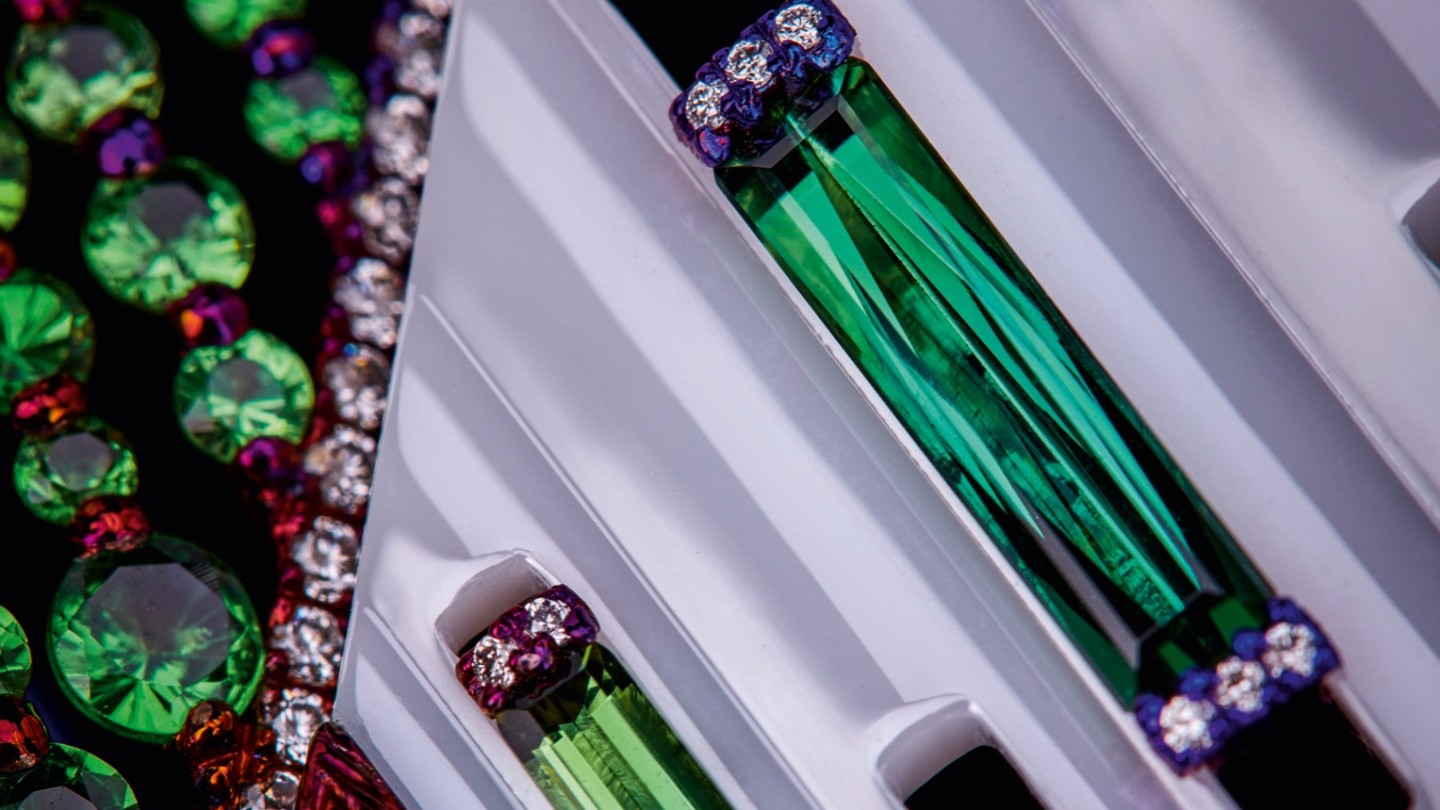
Roula Khalaf, Editor of the FT, selects her favourite stories in this weekly newsletter.
In an industry as ancient and deeply traditional as jewellery, change is anathema. Yet new and thrillingly high-tech innovations and space-age materials are radically transforming the look, feel and creative expressions of the jewel. Technical wizardry is liberating design, stimulating artistry, building previously unimaginable structures and revolutionising the jewellery universe.
Titanium, strong as steel and only 6o per cent denser than aluminium, with an ability to take on a spectrum of sensational colours, has brought unprecedented volume to jewels, particularly to earrings and brooches where weight is an issue. Identified in the 18th century, titanium was used in the US aerospace programme in the ’50s, and made a brief appearance in ’70s studio or “craft” jewellery, before becoming mainstream in the ’90s.

Today, titanium is increasingly appearing in high jewellery, as in De Beers’ The Alchemist of Light collection, injecting colour, texture and movement into diamond jewellery – with the help of aluminium, which is similarly light and subversively un-jewel-like. “This is the most creatively and technically ambitious collection we have ever conceived and crafted,” says CEO Celine Assimon. Fabio Salini uses aluminium and diamonds to create his Helix earrings, pioneering a “torsion” technique to twist and sculpt the material. “It is both mechanical engineering and a more artistic way to master the metal,” he says.


G Suen Studio Midnight Magnolia ring, POA
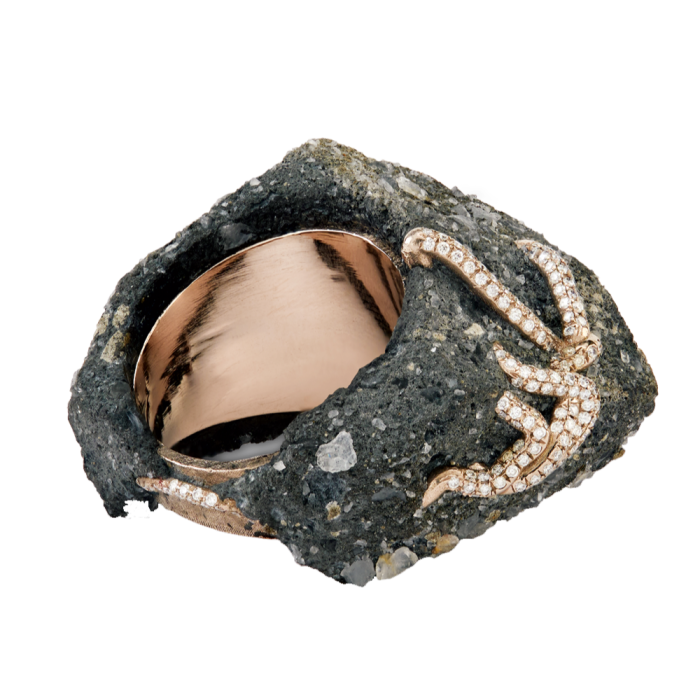
Studio Renn gold, acid-treated concrete and diamond Strangler ring, $9,000
Even more industrial is the velvety-black carbon fibre that Salini tames for other designs, while in Rome, the brilliant mosaicist Maurizio Fioravanti, of Vamgard, uses carbon fibre to turn micro-mosaics into light, contemporary works of art.
In Vienna, the alchemist jeweller Thomas Hauser of Atelier Allure spent a year exploring how to master Niellium, a tough, precious alloy that is mystically black. He sculpts Niellium into his Choreutai series of 12 rings, and adds black diamonds to his five Massive Champagne rings. Hauser talks of the “beauty of shadows”, seeing Niellium as a “magnificent antithesis to the light, reflections and refractions” that play a central role in jewellery.
Indian husband-and-wife duo Rahul and Roshni Jhaveri of Studio Renn use concrete in their designs. For their Strangler ring, a wriggling organic line of diamonds appears to be growing through the concrete, a study in atrophy and a reference to the urban environment of Mumbai, where they live and work. The concrete is surface-treated with acid, which they allow to do its work, handing over creative control to the environment.
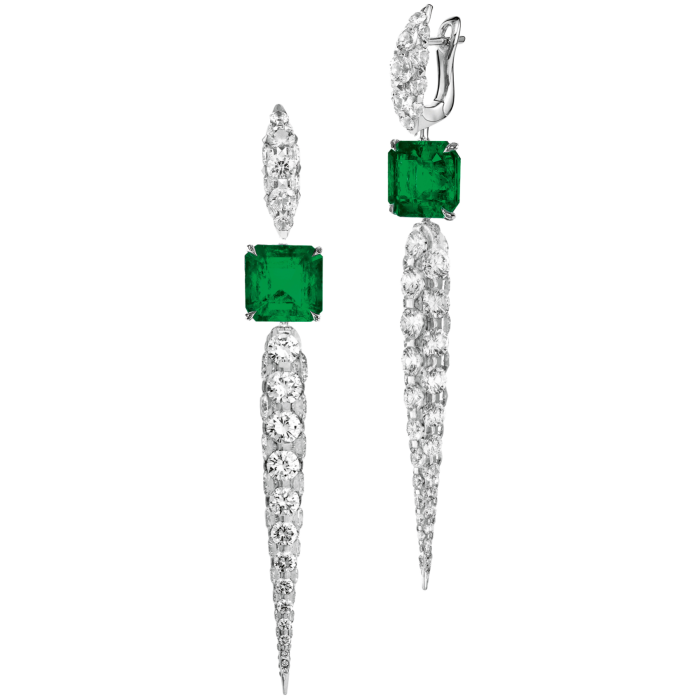
Boghossian white-gold, diamond and emerald Merveilles Icicle earrings, POA

Vamgard by Maurizio Fioravanti carbon-fibre, diamond and micro mosaic ear pendants, $90,000

Ceramic is another material that has been refined and improved to reach technical and creative sophistication. A style signature of New York-based designer-jeweller James de Givenchy, it injects jewellery with colour, texture and modernity. Meanwhile, in Hong Kong, Wallace Chan, the master craftsman renowned for his technical virtuosity (including his work in titanium) has taken ceramics to a new level with his unbreakable porcelain. Launched in 2018 after seven years of research and development, Chan’s porcelain is five times harder than steel, possesses a lustrous sheen and rich milky-opaque colours. The idea, he says, came from a childhood memory of a treasured porcelain spoon that slipped from his hand and shattered. Chan sculpts the porcelain into voluptuous organic shapes, embedded with gemstones set into titanium structures. It is, he says, both rooted in Chinese culture and resolutely contemporary.
“Innovation is about being open-minded,” says Claire Choisne, the creative director of Boucheron. “It is simply a tool, used not for its own sake but to achieve my dreams.” Her research is extreme. For Fleurs Éternelles, using real petals, she worked with scientists who usually scan mice and rats. For Contemplation, capturing celestial evanescence, she consulted with Nasa technicians to fill a pendant with aerogel to recreate a drop of sky, while an IT specialist plotted an algorithm for the Cloud necklace, a mass of diamonds floating on titanium thread.

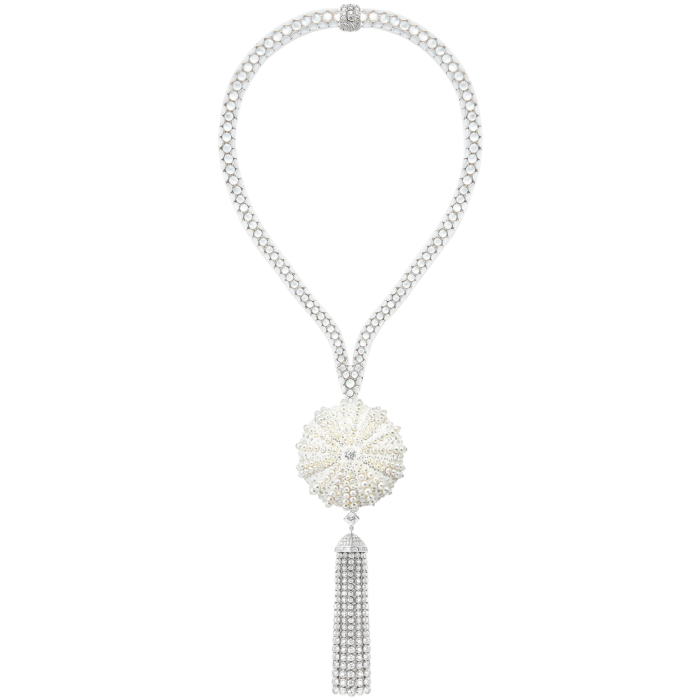
Boucheron white-gold, silver, diamond, pearl and mother-of-pearl Oursin Diamant necklace, POA
For the Ailleurs collection, Choisne’s imagination took her “elsewhere”. It explores the raw beauty of the natural world, incorporating natural materials, rattan, wood, butterfly wings, shells and pebbles from a Greek beach. The anodised aluminium of the Feuillage bangle is crafted to look like woven palm leaves, and for the Volcano Man necklace, the spiral structure of a shell was airbrushed onto mother-of-pearl, creating an otherworldly effect.
When it comes to techniques, the most transformative and boundary-breaking is CAD (computer-aided design) and the accompanying 3D printing of resin models for casting, which has become more widely used in the past decade but still gets a bad rap as a mass-production process or an automated shortcut. But as Sam Sherry, head of CAD and workshop manager at Graff tells me, in the hands of skilled designers, it’s a tool to enhance creativity, not to replace it, and is particularly invaluable in the miniaturisation of mechanical elements. “In a complex necklace that has to follow the contours of the neck, for example, every component has a joint, which has to be strong and uniform. This is almost impossible to achieve to the same degree by hand.”

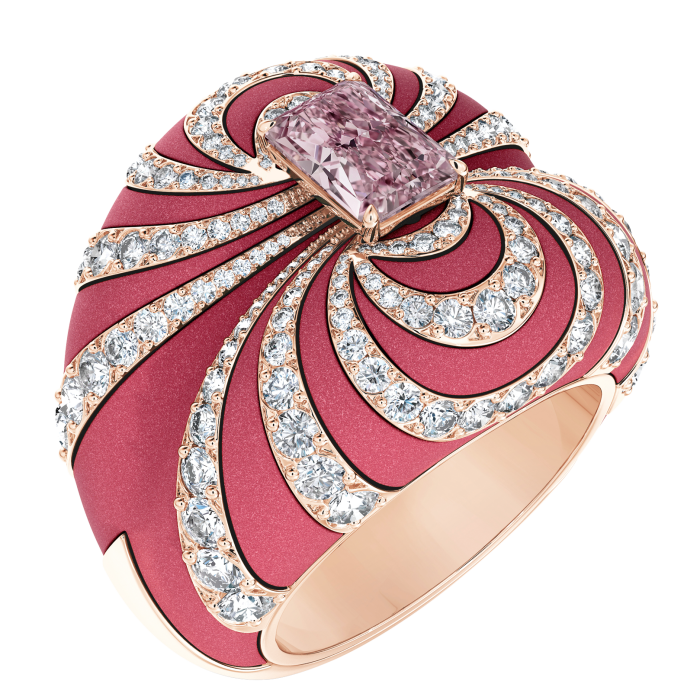
De Beers rose-gold, rose aluminium and diamond Optical Wonder Pink ring, POA
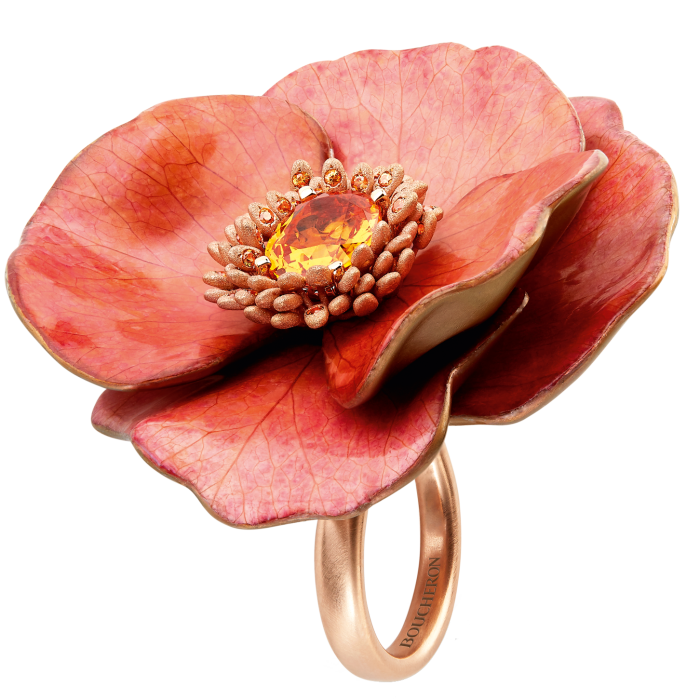
Boucheron pink-gold, titanium, spessartite garnet and orange garnet Rose d’Équateur Fleur Eternelle ring, POA
For Graff’s high jewellery, CAD is used in conjunction with traditional techniques. From a handpainted gouache design, the layout of stones is then digitised by an ultra-high-res scanner. The components for mounting and articulations are then 3D-printed in a special resin with a high wax content, and cast using the age-old lost-wax method. Sherry emphasises that CAD requires both aesthetic and technical prowess, and Graff trains experienced diamond mounters to use the software, often for years. “It is about problem-solving, but always with beauty in mind.”
Problem-solving is what drives Boghossian and its Hong Kong-based creative director, Edmond Chin, to devise its ingenious signature gem-setting techniques. Chin’s aim is to achieve lightness and fluidity and minimise metal to the point of invisibility. In Merveilles, intended as a modern evolution of pavé-setting, stones are held back to back with no visible means of support, kept in place on a hidden internal structure and by the tension of their positioning. The effect is a scintillating unbroken stream of diamond light.
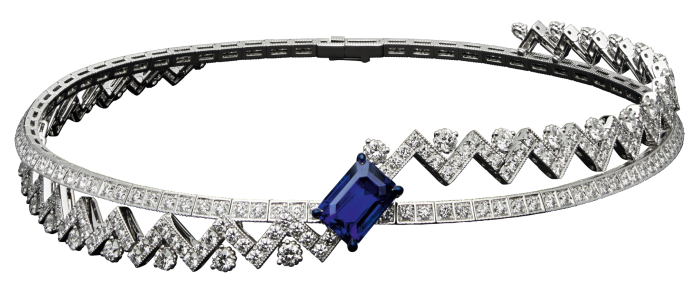
Dior Joaillerie white-gold, diamond, sapphire and blue-lacquer Galons Dior necklace, POA
Gem-setting techniques, especially, continue to be refined in order to bring a sense of movement to classic set jewels. In its Ondes et Merveilles high-jewellery collection, Chaumet introduced “scale-setting” for diamonds, overlapping stones to produce a vision of a mermaid’s tail and adding depth and lusciousness to ocean-themed creations. For the Galons Dior collection, the house’s creative director of jewellery, Victoire de Castellane, was able to replicate the effect of braided fabric, a signature couture detail, by mixing a multitude of different settings, cuts and shapes of gems. After extensive research, the ateliers created settings with jaunty angles, staggered lines, zigzags or serpentines, giving the impression of patterns and textures, all twisting together in joyful, disordered movement.
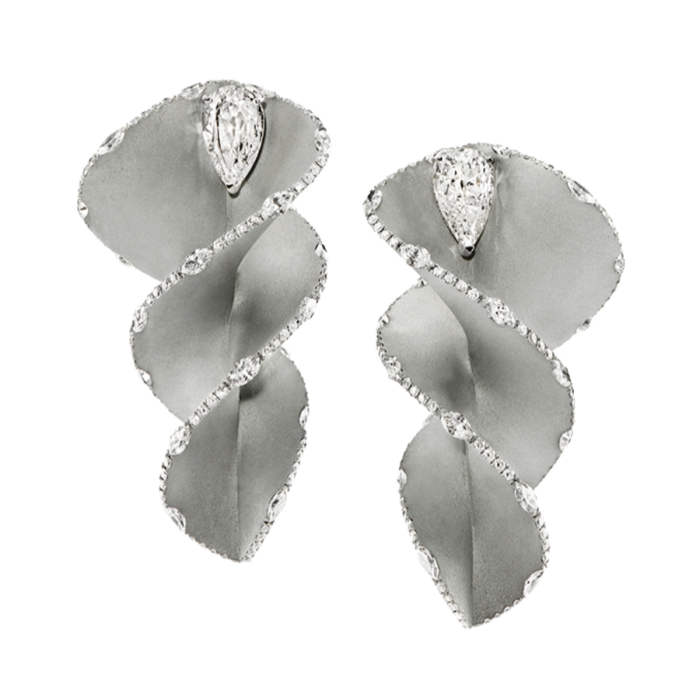
Fabio Salini aluminium and diamond Spirale earrings, POa

Oktaaf gold, silver and enamel 2001 bolts and nuts cufflinks, $27,500
Finally, there’s a futuristic element to today’s fast-moving jewellery innovations. London-based designer Gearry Suen, working with his business partner Jing Zhao, uses virtual reality to “delve deeper” by stepping into their jewels. “VR allows us to take a 2D sketch or painting to a realistic 3D model, which makes the jewel come alive at an early stage of the creation process,” Zhao explains. “We can magnify the images such that a 1mm detail becomes a 3m-tall object, and use it to optimise the design. They come alive beyond anything that can be achieved on a regular screen.”
Meanwhile, Oktaaf, a new, Madrid-based jewellery brand established by Belgian internet entrepreneur Karel de Beule and Spanish designer Ainoa Corres, has created a pair of cufflinks using AI. The 2001 Bolts and Nuts are designed around two titanium screws from Apollo 15, and are inspired by Stanley Kubrick’s 2001: A Space Odyssey. De Beule, who has an engineering degree in AI, and Corres researched AI technologies and found a laboratory in Russia willing to take on the challenge. Corres submitted a creative mood board, which was then adapted so that the machine began to “dream up shapes”. It took seven months of work, including the interpretation of the chosen design by Corres, and crafting and hand-finishing the cufflinks. It is the perfect expression of a now historic sci-fi drama and futuristic technology. Or as Suen says: “A bridge between tradition and innovation, connecting the past not only with the latest technologies but with the future.”
Comments